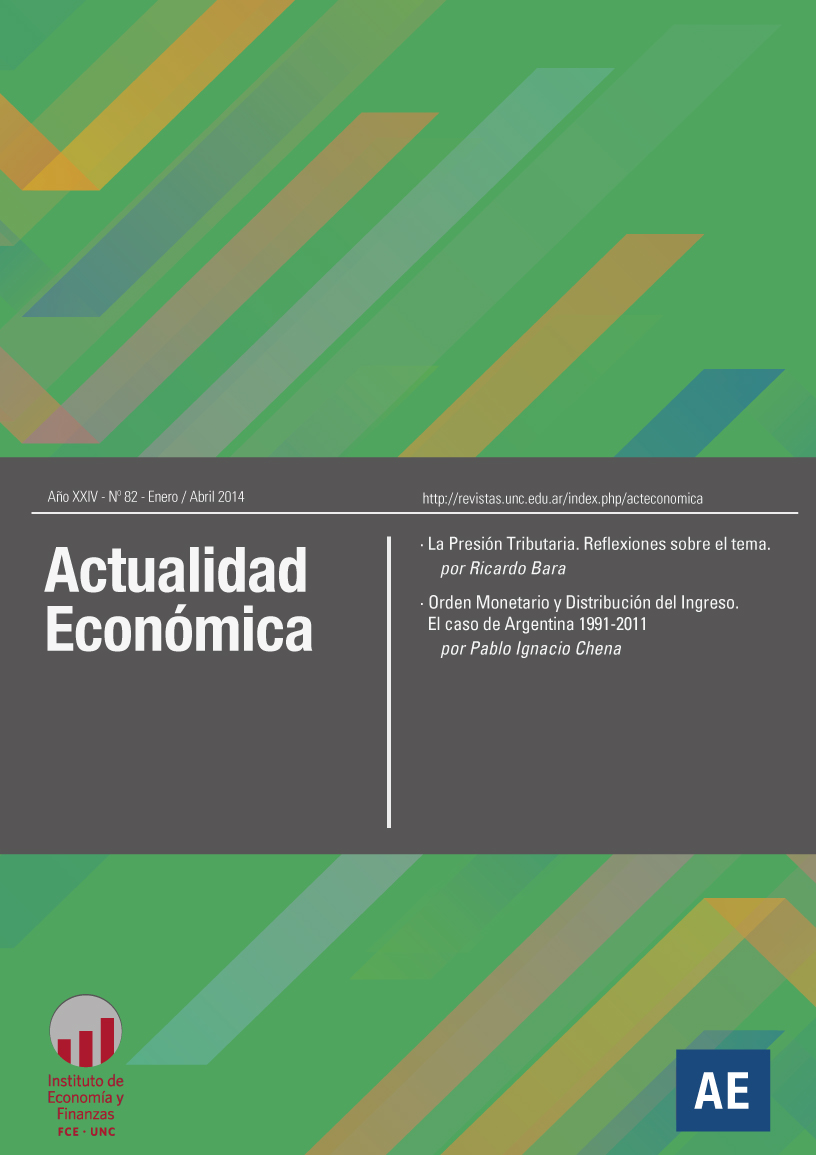Monetary Order and Income Distribution. The case of Argentina 1991-2011
Keywords:
Currency, Central Bank, Income Distribution, ArgentinaAbstract
The present article analyzes the relationship that exists between the income distribution and the institutions of monetary order based on two complementary theoretical schemes. First, we turn to the institutionalist monetary theory of Aglietta and Orléan, to account for the institutional mechanisms through which the monetary regime biases the income distribution between creditors and debtors, depending on the functions assigned to the Central Bank. Second, the focus of the monetary circuit is used to explain the power that commercial banks have in the selection of companies and / or sectors that will be winners or losers in the distributive struggle. Finally, the modifications to the monetary order that occurred in Argentina during the neoliberal period (1991-2001) and post-neoliberal period (2002-2011) and its effects on the distribution of income are studied.
Downloads
References
Aglietta, M. y Orléan A. (1990 [1982]), La violencia de la moneda. México: Siglo Veintiuno Editores.
Aglietta, M. y Orléan A. (2002), La monnaie, entre violence et confiance. Paris: Odile Jacob. Allais, M. (1947). Économie et intérêt. Paris: Imprimerie Nationale.
Arestis, P. y Howells P. (1996), “Theoretical reflections on endogenous money: the problem with convenience lending”, Cambridge Journal of Economics, Vol. XX, Nº 5.
Bellofiore, R. (2005), “The Monetary Aspects of the Capitalist Process in the Marxian System: An Investigation from the Point of View of the Theory of the Monetary Circuit”. En Fred Moseley, Marx Theory of Money, Massachusetts: Mount Holyoque College.
Bleger, L. (2000): “El proceso de concentración y extranjerización del sistema bancario argentino durante los 90”, en Boletín Informativo Techint, N° 301, enero-marzo.
Dollar D. (1992), “Outward-oriented developing economies really do grow more rapidly: Evidence from 95 LDCs, 1976.1985, Economic Development and Cultural Change, Vol. 40, Nº 3.
Deleuze G. y Guattari F. (2013), El anti Edipo. Capitalismo y esquizofrenia, Buenos Aires, Ediciones Paidos.
Gramsci, A. (2011), Notas sobre Maquiavelo, Buenos Aires: Nueva Visión.
Graziani, A. (1988), “Il circuito monetario”, en Augusto Graziani, Marcello Messori. Moneta e produzione, Torino: Einaudi.
Guttman, R. (1997), “Moneda y crédito en la teoría de la regulación”, en Boyer y Saillard (eds.), Teoría de la Regulación: estado de los conocimientos, Vol. I., Buenos Aires: Asociación Trabajo y Sociedad-UBA.
Lavoie, M. (1992), Foundations of Post-Keynesian Economic Analysys. London: Edward Elgar. Publishing Limited.
Marques-Pereira, J. (2007), “Monnaie, coordination et risque systémique dans la crise argentine de 2001/2002 et son issue”, Economie et Institutions, vol 10, septiembre.
Panigo D. y Chena P. (2011), “Del neo-mercantilismo al tipo de cambio múltiple para el desarrollo. Los dos modelos de la post-Convertibilidad”, en Ensayos en Honor a Marcelo Diamand. Las raíces del nuevo modelo de desarrollo argentino y del pensamiento económico nacional, Miño y Dávila/Universidad Nacional de Moreno/CEIL-PIETTE-CONICET.
Hausmann R., Pritchett L. y Rodrik D. (2005); “Growth Accelerations”, Journal of Economic Growth, Nº 10.
Levy-Yeyati E. y Sturzenegger F. (2007), “Fear of Floating in Reverse: Exchange. Rate Policy in the 2000s,” mimeo.
Parguez A. (2006), “Moneda y capitalismo: la teoría general del circuito”, En Alicia Girón, Confrontaciones monetarias: marxistas y post-keynesianos en América Latina, Buenos Aires: CLACSO.
Peralta Ramos M. (2007), La economía política Argentina: poder y clases sociales, Buenos Aires: Fondo de Cultura Económica, Buenos Aires.
Razin O. y Collins S. (1997); Real Exchange Rate Misalignments and Growth, Georgetown University.
Rodrik D. (2008), “The real exchange rate and economic growth”, Brookings Papers on Economic Activity, Vol. 2.
Rochon, L. (2001), “Cambridge’s Contribution to Endogenous Money: Robinson and Kahn on credit and money”. Review of Political Economy, Vol. XIII, Nº3.
Downloads
Published
Issue
Section
License
Those authors who have published with this journal, accept the following terms:
Authors will conserve their copyright and guarantee the magazine the right of first publication of their work, which will be simultaneously subject to the Creative Commons Attribution-NonCommercial-NoDerivative 4.0 International License that allows third parties to share the work as long as the author and first publication of this magazine are indicated.
Authors may adopt other non-exclusive license agreements to distribute the published version of the work (e.g., deposit it in an institutional telematic archive or publish it in a monographic volume) provided that the initial publication in this journal is indicated.
Authors are allowed and encouraged to disseminate their work through the Internet (e.g., in institutional telematic archives or on their website) before and during the submission process, which may lead to interesting exchanges and increase citations of the published work. (See The effect of open access)









